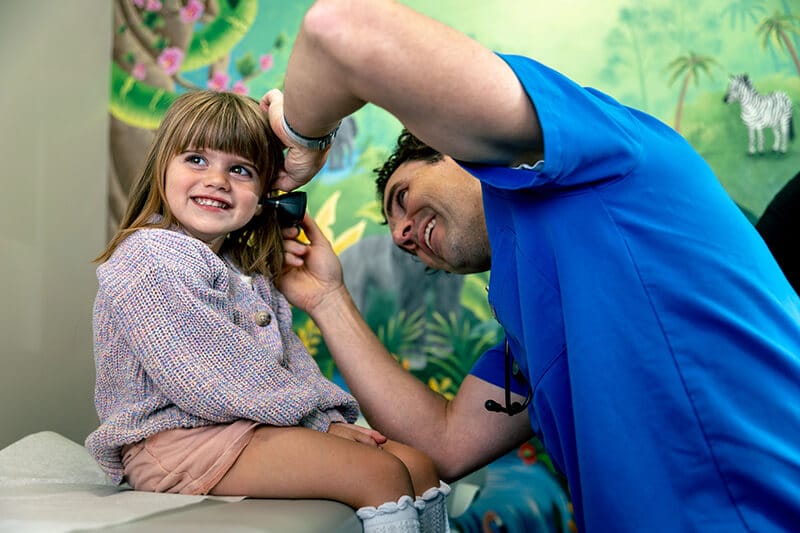This has been a tough 18 months. Just when we think the clouds are starting to clear, the storm has swooped in again to wreak havoc on our lives. To make it even harder, one weatherperson is saying it’s barely misting, another is reporting a torrential downpour and the third is telling us it’s a beautifully sunny day. As a parent, this has been maddening. I’d like to offer some information which is based only upon what the science is telling us and has no political undertones to it. That being said, there may be disagreement from many of you about the weather I’m predicting. That’s fine, but please be assured that I’ll do my honest best to tell you, from a medical viewpoint, what this means for you and your kids. Yes, this is long and there are a bunch of numbers, but I’ve tried to make it as readable as possible and up to date as of August 2021.
What is a variant?
There are several different ‘names’ which have been given to the variants over the past year. Most recently they have been renamed after the letters in the Greek alphabet. Alpha (the UK strain), Beta (the South Africa strain), Gamma (the Brazil/Japan strain) and Delta (the India strain) are the most common. But what, exactly, is a variant? Any virus, be it coronavirus or influenza (the flu), has one driving desire. It wants to replicate and make more virus. It doesn’t think about what it’s doing nor is there evil intent, it just does what it does. When it is replicating, sometimes a random mutation will occur in its genetic make-up, this offspring is called a variant because it is slightly different from the original virus. Most the time when this happens, it actually makes the virus less contagious. As a result, because it is less efficient at replicating, after a few cycles it burns itself out. Sometimes the mutation has no effect on how contagious the virus is so, it just keeps going at the previous pace. Unfortunately, sometimes the random mutation allows it to become much more contagious. When this occurs, the variant infects more people, replicates more and in turn infects even more and soon becomes the dominant strain. This is why almost all of the COVID infections since July, in Utah (and the United States), have been the Delta variant.
Aside from contagion, another attribute which can change with mutations is the virus’ virulence. Virulence is how sick any virus makes its host (all of us). It’s actually not always in the virus’ best interest for it to be more virulent because if it’s host gets very ill and either quickly dies or isolates due to the illness, it can’t easily find a new host to infect and it’s ultimate goal in life, replicating, doesn’t occur. This is why SARS-CoV2 (which is the name of the virus and stands for Severe Acute Respiratory Syndrome COronaVirus 2) is so good at causing COVID-19 (the actual illness, COrona VIrus Disease 2019). While some people get very ill, many will be asymptomatic (have no symptoms) or mildly effected, so they can still mingle with other hosts and easily infect others. This variability in virulence is why COVID is so confusing. For some people, it is very severe and even lethal, some get absolutely no symptoms, but most get fairly sick, yet don’t get admitted to the hospital, similarly to the flu. However, COVID is not the flu, as I will discuss below.
What we know
Delta is far more contagious than the original virus or any other variant we have seen thus far. You may have heard that it is “more contagious than chickenpox”. Fortunately, that statement doesn’t mean a lot to people because many have no idea how contagious chickenpox was. That’s because of vaccines, but we’ll get to that in a bit. To put this in perspective, for the original COVID virus, each infected person will infect, on average 1.8 other people. For Delta, each infected person will infect 5-9 other people.
Kids can contract and spread Delta just as easily as adults especially those older than 10 years of age. Thankfully, they are less likely than adults to get seriously ill with COVID. Yet, they are at high risk for developing Long COVID, as discussed below. Additionally, COVID infections can cause some children to be hospitalized and is twice as lethal as our worst flu year so certainly something to avoid.
Previous infection with non-Delta COVID (basically any COVID infection before June 2021) does not provide consistent protection from either contracting or becoming very ill with the Delta variant.
Vaccination provides very good protection from contacting COVID and extraordinary protection from actually being hospitalized or dying from COVID. As of August 9, the CDC has reported 5725 Americans who were fully vaccinated and had a severe breakthrough COVID infection, defined as either being hospitalized or dying from their infection. This is out of over 167,354,729 Americans who were fully vaccinated at the time. That means that only 0.003% of fully vaccinated people have had a severe breakthrough infection from COVID and only 0.0007% have died. That’s only 1 of 29,232 fully vaccinated people with severe infection and 1 in 140,634 fully vaccinated people who have died of their breakthrough infection. Of course, your risk of developing an asymptomatic or mild COVID infection is higher. It varies among States but is between 0.01-0.2% of fully vaccinated people. That is completely expected as no vaccine is 100% effective in preventing infection, the role of any vaccine is to prevent severe infection. With this in mind, the COVID vaccines are between 99.8-99.99% effective in preventing asymptomatic or mild infection, 99.997% effective in preventing severe disease and 99.9993% effective in preventing death.
There has been a lot of talk about the July COVID outbreak in Massachusetts which spurred the CDC’s newest guidelines regarding masks (recommending that even vaccinated people wear masks inside) and much of what I have been hearing has been misinterpreted. It revolved around a festival occurring in a small town on the tip of Cape Cod. About 60,000 people attended for the week and it was similar to the crowds and festivities you’d expect from Spring Break in Florida with lots of partying in bars and other indoor places (as it was raining) with little social distancing or mask use. About 69% of the attendees were fully vaccinated. In essence, this was a massive stress test for the efficacy of the COVID vaccine. Among the fully vaccinated, 346 tested positive and 4 were hospitalized, there were no deaths. That is out of an estimated 41,400 vaccinated partiers. That’s about 0.8% chance of getting COVID and 0.009% chance of being hospitalized from it. Again, this was with a massive party, mostly indoors with little social distancing or masking. By any account, the vaccines performed much better than expected!
The reason the CDC mask guidelines were changed is because the studies showed that fully vaccinated individuals with COVID had the same amount of viral load as those who were unvaccinated and therefore could spread the virus as well. Importantly, fully vaccinated persons were contagious a much shorter time than those who were vaccinated, and, again, had very little chance of getting ill compared to those who were unvaccinated. While the CDC did not explicitly say this, the reason they have asked fully vaccinated patients to mask up indoors and in crowds is not to protect themselves, it is much more to protect the unvaccinated. While on the face of it, this may seem unfair to ask those who have already done their part to mask again to protect people who aren’t willing to protect themselves. Yet it is much more than that, there are many who cannot vaccinate due to medical reasons. Most importantly, for us, it also includes all our children, less than 12, who do not have the ability to be vaccinated.
People tend to compare COVID to influenza (the flu), an illness which can be very severe for some, but, generally, we have learned to live with. For some people their COVID symptoms may be mild enough that it may seem like a reasonable comparison. The medical fact, though, is that COVID is far more devastating than the flu. For an average flu year, 22,000-60,000 Americans die, fatalities are almost entirely in the elderly. Over 600,000 Americans have died from COVID since April 2020, and while many are elderly, 104,802 of deaths from COVID were in Americans less than 65. The 2019-2020 flu year had the highest pediatric deaths in decades, 199 deaths in Americans 0-17 years of age. As of today, there have been 457 deaths from COVID in Americans 0-17 years of age. This is only taking into account deaths, the number of Americans hospitalized from COVID is far higher. Plus, it is very unusual for influenza to cause significant disease after its initial infection, this is not the case for COVID.
Long COVID is when people have one or more symptoms for greater than 4 weeks following infection. Most symptoms are fatigue, shortness of breath, chest pain, cough, inability to smell or taste and brain fog (inattention, anxiety, poor memory). These symptoms seem to resolve within a few months for some, but they have been lasting much longer for others and could be permanent. It appears that this occurs 30-50% of the time for adults. Thankfully, it is happening less often in children but still close to 10-20% of the time in kids 12 years of age and up. This is not seen with influenza.
Masks are very effective in curtailing the spread of the disease and, while uncomfortable, are not dangerous to the health of adults or kids. But while effective, they pale in comparison to vaccines in their efficacy in preventing any kind of COVID infection.
We know that the vaccine is very safe and incredibly effective for every known variant, including Delta. As expected, there are typical mild side effects of pain around the injection site, fevers, chills and fatigue. There is one more serious potential side effect we know of, inflammation of the heart (myocarditis), mostly in teenage boys and young men. While not yet definitively proven, it is likely related to our response to the vaccine. Here is what we currently know:
It is very rare, 41 males/1,000,000 doses given (as of June 2021, ages 12-29). Even more rare in teenage girls and women, 4.2 cases/1,000,000 doses given. Of the people who developed myocarditis, it was mild and most fully recovered after a few days to weeks.
What most people don’t know, is that myocarditis occurs after natural COVID infection. In May 2021, cardiologists studied a group of 1,597 college athletes who had naturally contracted COVID. Overall, 2.3% of these athletes had myocarditis, thankfully, just like in the vaccinated patients, it was mild and they all resolved completely.
To summarize, it does appear that the mRNA COVID vaccines (Pfizer and Moderna) can cause mild myocarditis, but so does natural COVID and at a much higher rate. In general, a young male has a 2.3% likelihood of developing it from a natural COVID infection and a 0.0041% chance of developing it from a COVID vaccine. Put another way, a young male’s risk of developing myocarditis is 561 times higher after natural COVID infection versus the vaccine.
Another concern people may have heard about is infertility with the COVID vaccine in women. Back in March 2020, it was thought that a protein on the placenta appeared similar to the COVID spike protein. If this was true, when our body naturally makes antibodies to the spike protein after either a COVID infection or vaccination, the antibodies could recognize the placental protein as foreign and attack it. Of course, this was taken very seriously and thoroughly evaluated. It turns out that the placental proteins do not have a cross-reaction to our anti-COVID antibodies (whether from vaccination or natural infection). If it is any solace, all three of my daughters have gotten vaccinated and I have no concerns regarding their future fertility.
What we don’t know
While pediatric hospitals in Utah, and across many parts of the country, are seeing more kids being admitted to the floor and the intensive care units with COVID, it is not entirely clear that the Delta variant is causing more serious disease. It could be just because the overall numbers are dramatically up, which, inevitably, leads to more kids being hospitalized. Many pediatric ICU docs do believe it is causing more serious disease. Like many things with COVID, we will know more in the next few months.
Because these specific vaccines are so new, we don’t have any long-term data regarding exactly how long they work (though the CDC just recommended a booster 8 months after the second dose) or if there could be safety concerns several years down the line. We do know that in the short term, they are incredibly effective in kids 12 and up. We also know that the risk of contracting COVID, if unvaccinated, is extremely high, and the risk of Long COVID (chronic) symptoms from this is substantial, even in kids. For me, and my family, these risks far outweigh the very unlikely possibility of long-term effects from the COVID vaccines.
It is not yet clear whether fully vaccinated people who then develop COVID are also at risk for Long COVID symptoms. We know, for sure, that your risk of developing Long COVID is zero if you don’t ever contract COVID, so preventing infection is key.
Where do we go from here
COVID is not going anywhere. Just like influenza, and the vast majority of other illnesses, it will be with us for decades and we will need to learn to live with it. Most doctors believe that it is no longer a question of IF but WHEN an unvaccinated person will develop COVID. Our risk will never be zero and that is an unattainable goal. However, if we could turn the risk of COVID into the annual risk we have with the flu, most of us believe that is an achievable and reasonable outcome. In effect, the vaccine, with the example of the Cape Cod outbreak, does just that. The likelihood of getting infected at all or being hospitalized was about the same risk the average adult takes each year with the flu. This should be our goal and it is within reach. But to do that, we need a few things to occur:
- More people eligible to be vaccinated need to get the vaccine. The FDA just granted full approval to the Pfizer COVID vaccine from 16 years of age and up. These vaccines have been very thoroughly evaluated and are safe and effective. This is far and away the best way to achieve this goal and return life to normal.
- We need a vaccine for kids younger than 12. We expect some data to arrive by September and before we can recommend it, we need to know if it is safe and effective. However, if the data is as good as it is for 12 and up, I would recommend it.
- In the meantime, until we can effectively decrease the population’s risk through vaccination, we need to mask up while indoors if we don’t know the vaccination status of the people we are with. Sadly, this includes schools, especially kids K-6 where we know none of the students are protected by vaccination. It’s a small thing to ask to help keep our children safe.






